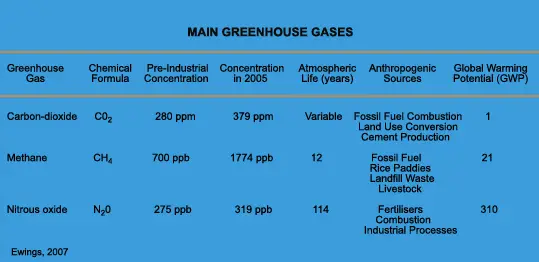All greenhouse gases have what is called a Global Warming Potential (GWP). This value is used to compare the abilities of different greenhouse gases to trap heat in the atmosphere. GWPs are based on the heat-absorbing ability of each gas relative to that of carbon dioxide (CO2), as well as the decay rate of each gas (the amount removed from the atmosphere over a given number of years). GWPs can also be used to define the impact greenhouse gases will have on global warming over different time periods or time horizons. These are usually 20 years, 100 years and 500 years. For most greenhouse gases, the GWP declines as the time horizon increases. This is because the greenhouse gas is gradually removed from the atmosphere through natural removal mechanisms, and its influence on the greenhouse effect declines. Some of the CFCs however, have long atmospheric lifetimes, and the 100-year GWP may be greater than the 20 year GWP.
By assigning a GWP value it allows policy makers to compare the impacts of emissions and reductions of different gases. For instance, methane is a significant contributor to the greenhouse effect and has a GWP of 21. This means methane is approximately 21 times more heat-absorptive than carbon dioxide per unit of weight.
By looking at the table below you can see nitrous oxide is 310 times more absorptive than carbon dioxide, and can linger in the atmosphere for over a hundred years. However, through sheer quantity carbon dioxide is the most problematic of greenhouse gases, although if the Earth warms too rapidly, methane emitted from permafrost areas could outweigh carbon dioxide.

